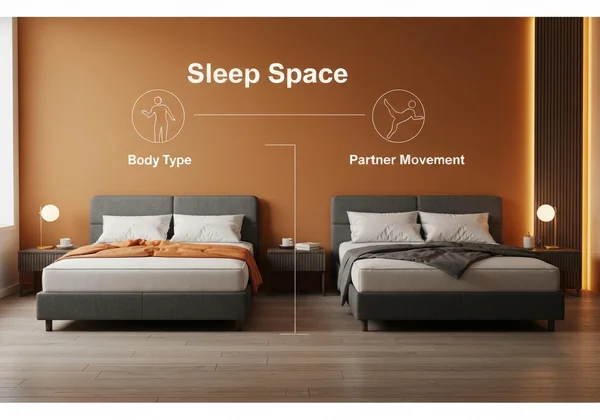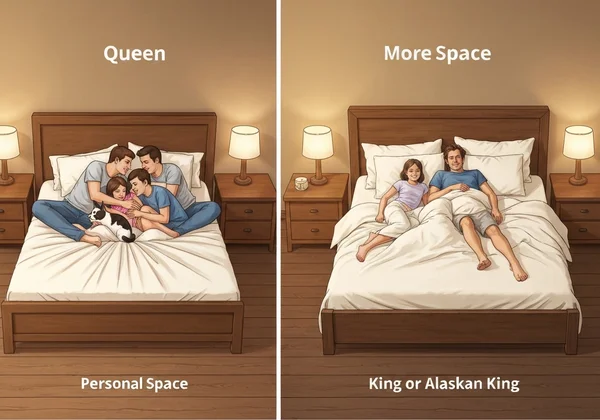Bed Sizes Guide: Choosing Your Perfect Mattress Based on Sleep Position, Body Type & Partner Movement
Choosing the perfect mattress size often feels like a simple equation of bedroom dimensions. However, the true path to restful sleep is far more personal. Your unique sleep position, specific body type, and whether you share your bed can dramatically influence your comfort and overall sleep quality. This guide aims to simplify mattress sizing, showing you exactly why your personal factors are the most important clues in finding your ideal bed. What size bed should I get to ensure perfect sleep every night?
The answer lies in understanding your individual needs. While a tape measure can tell you if a bed will fit in your room, it can't tell you if it will fit you. That’s why we’ve broken down the key personal factors that our intelligent recommendation tool uses to find your perfect match. To get a personalized answer in seconds, find your perfect mattress size with our free tool.

Tailoring Mattress Size for Your Sleep Position
How you sleep is one of the most significant predictors of the mattress size you need. Each position requires a different amount of space for optimal comfort and alignment.
Side Sleepers: Ensuring Room for Comfort & Alignment
As a side sleeper, you naturally curl your legs and extend your arms, adopting a wider profile than back or stomach sleepers. A narrow mattress, like a Twin, can leave you feeling cramped, with limbs dangling off the edge. To achieve proper spinal alignment, you need enough width to accommodate your entire frame comfortably. A Full mattress is a minimum for a single adult, but a Queen or King provides ample room to shift without disrupting your sleep.
Back Sleepers: Optimal Support and Spread
Back sleeping is excellent for spinal health, but it requires sufficient surface area. A proper bed size for back sleepers allows you to spread out naturally, preventing your shoulders from feeling pinched and your arms from being forced into an uncomfortable position. While a Full size can work for a single person, couples who sleep on their backs will find a Queen confining. A King size offers the luxurious width needed for both partners to rest without encroaching on each other's space.
Stomach Sleepers: Minimizing Pressure Points
Stomach sleeping can put pressure on the spine, making space a critical factor for comfort. A stomach sleeper mattress must be wide enough to allow you to position your arms and legs comfortably without twisting your back. If you feel constrained, you may contort your body into unhealthy positions, leading to aches and pains. A Queen size offers a significant upgrade in width over a Full, providing the room needed for better pressure relief.
Combination Sleepers: The Freedom to Roam
If you frequently change positions throughout the night, you are a combination sleeper. You need the most surface area of all. The best mattress for restless sleepers provides enough length and width to accommodate every toss and turn. A Queen size is often the starting point, but a King or California King offers the ultimate freedom to move without the risk of falling off the bed or disturbing a partner.

How Body Type Influences Your Ideal Bed Size
Your physical characteristics, including height, weight, and build, are fundamental data points for choosing the right mattress. A bed that feels spacious to one person might feel restrictive to another.
Height: When Standard Length Isn't Enough
For individuals over 6 feet tall (183 cm), standard mattress lengths can be a constant source of frustration. A standard Twin or Full mattress is only 75 inches long, leaving taller individuals with their feet dangling off the end. The solution is a longer bed. A Twin XL adds 5 inches of length, making it ideal for tall individuals in dorms or smaller rooms. For the ultimate comfort, a California King is the top choice for a bed for tall person, offering a generous 84 inches of length.

Weight: Understanding Support, Sinkage, and Surface Area
Your weight influences how much you sink into a mattress and how much surface area you occupy. For a heavier person, a mattress needs to provide adequate support across a wider area to prevent excessive sinkage and maintain comfort. A heavy person mattress size like a Queen or King offers better weight distribution, ensuring the mattress feels supportive rather than constricting. For couples, a King size is often necessary to provide a stable and spacious sleep surface for both partners. Explore the complete bed sizes chart to compare dimensions.
Build: The Importance of Personal Sleeping Space
Beyond height and weight, your general build, such as shoulder width, plays a role. Individuals with broader shoulders may find narrower beds like a Full to be constricting, even if they sleep alone. Having a spacious bed size is not just a luxury; it's essential for allowing your muscles to relax fully. Before you decide, it’s crucial to consider your personal "comfort bubble" and ensure your chosen mattress provides enough room to feel completely at ease.
Partner Movement: Minimizing Disturbance for Better Sleep
Sharing a bed introduces a new set of variables. Your partner’s movements, sleep habits, and even the presence of children or pets can turn a cozy bed into a source of nightly disruption.
Sharing a Bed: Essential Width for Two
While a Full size bed is sometimes marketed for couples, it offers each person only 27 inches of personal space—the same width as a crib. This is rarely sufficient for two adults to sleep comfortably. A Queen size is the most popular choice for couples, but a King is widely considered the best bed for couples. It provides each person with the equivalent of a Twin XL mattress, ensuring ample room and personal space for undisturbed rest.
Motion Transfer: Why More Space Reduces Disturbance
If you are a light sleeper, a partner's tossing and turning can be a major issue. Motion transfer is the ripple effect of movement across a mattress. A larger mattress provides better motion isolation simply because there is more surface area to dissipate the energy. Upgrading from a Queen to a King can significantly reduce how much you feel your partner's movements, leading to a deeper, more restorative sleep.
Co-Sleeping with Kids or Pets: Maximizing Family Comfort
When children or pets join you in bed, space becomes the ultimate commodity. A Queen bed can quickly become overcrowded, leading to a restless night for everyone. The expansive width of a King size makes it the ideal family bed size. It provides plenty of room for everyone to cuddle up without forcing parents to the very edge of the mattress. For maximum space, an Alaskan King offers an unparalleled sleeping surface for the entire family. Get your recommendation to see if a King is right for you.

The Intelligent Logic Behind Our Bed Size Recommendation Tool
Understanding these factors is the first step, but putting them all together can be complex. That’s where our smart recommendation tool comes in. It takes the guesswork out of the equation by analyzing your unique data.
Combining Your Inputs: A Holistic and Personalized Approach
Our tool doesn't just look at one or two variables. It processes your height, weight, sleep position, partner information, and even bedroom size simultaneously. This holistic method ensures you receive a truly personalized mattress recommendation tailored to your specific situation. It considers how a tall side sleeper who shares a bed has vastly different needs than an average-height back sleeper who sleeps alone.
Beyond Dimensions: Integrating Comfort & Lifestyle Factors
We go beyond raw numbers. The algorithm also integrates crucial lifestyle details, such as sensitivity to partner movement and personal space preferences. These mattress comfort factors are essential for a recommendation that truly fits your life. Our goal is to provide a data-driven choice that leads to years of comfortable sleep. Try our free tool today to experience the difference.
Find Your Perfect Fit: Smart Choices for Better Sleep
Getting the right mattress is a big step for your health and well-being. By looking beyond simple room measurements and considering your personal sleep style, body type, and shared sleep habits, you empower yourself to make a truly informed decision. These factors are not just minor details; they are the core components of your sleep experience.
Tired of guessing? Let us help you find the mattress size that's scientifically matched to you! Visit BedSizes.net and use our intelligent recommendation tool. Answer a few simple questions and get an instant, data-driven suggestion for your perfect fit.
Frequently Asked Questions About Mattress Sizing Factors
What size bed should I get if I'm over 6 feet tall?
If you are over 6 feet (183 cm), you should prioritize length. A standard 75-inch mattress will be too short. Look for 80-inch long options like a Twin XL or Queen, or for maximum comfort, an 84-inch long California King. Our tool uses your height to automatically suggest sizes that provide adequate legroom.
Is a Full size bed truly comfortable for two average-sized adults?
While technically possible, a Full size bed is not recommended for two adults. It provides only 27 inches of width per person, which is very restrictive and can lead to sleep disruptions. For a comfortable experience, couples should start their search with a Queen size bed, which you can learn more about on our mattress size guide.
How does my preferred sleep position affect the ideal mattress length and width?
Your sleep position dictates how much surface area you occupy. Side sleepers require more width for their knees and arms, while combination sleepers need maximum space to move freely. Back and stomach sleepers also benefit from ample width to prevent feeling cramped. The ideal dimensions ensure your body remains fully supported in your natural sleep posture.
What's the best mattress size to minimize feeling my partner's movements?
To minimize motion transfer from a partner, a larger mattress is always better. A King size bed provides the most personal space and the greatest distance between sleepers, which naturally dampens the effect of movement. This additional space is often the key to undisturbed sleep for couples, especially if one is a light sleeper.